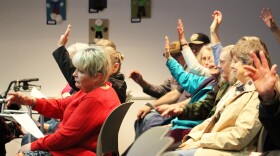The Cooper Landing Bypass project has been an idea since the 1980s, and an active road and bridge project since 2021. This summer is the busiest construction season yet on the project, which will reroute the narrow, busy Sterling Highway around the community of Cooper Landing.
But the project’s manager, Jonathan Tymick with the Alaska Department of Transportation, says a deficiency in this year’s legislative budget could push back the project timeline.
“It only incorporated a portion of the funding required to keep the Cooper Landing Bypass project, also known as the Sterling Highway milepost 45-60…to keep that project aligned with its current schedule,” Tymick said.
The bypass project is allocated about $60 million in the budget approved by the Legislature in May, which is still waiting on a signature from Gov. Mike Dunleavy. But Tymick said that’s only a portion of what DOT needed from the state to keep the project on track during the next fiscal year, which begins July 1.
And the Juneau Creek Bridge — the most expensive component of the project this year — isn’t included in the budget at all. He said that allotted $60 million will cover a project phase called 1B, which involves work on the east end of the new road. But combined with the bridge, he said the FY24 work had a $300 million price tag.
“So we’re very close to having the Juneau Creek Bridge at 100% design, so that’s very exciting,” he said. “And so hopefully this coming fall we can award that bridge [to a contractor]. It’s critical pass to get it awarded this fall.”
As DOT plans to finish up the design of the bridge this summer, it’s also set to order 6.5 million pounds of steel from the Lower 48, which Tymick said could be delayed. The bridge is set to be installed in 2026 — an event which Tymick said will be the longest bridge launch in the nation — and open to traffic in 2027. Without this year’s budget, he said that opening date is in jeopardy.
“If that doesn’t happen, I’m sure that maybe if the bridge doesn’t get fully funded, it might get partially funded, we would probably just order the steel, until the full funding arrives so that we could construct the bridge. And that would probably save some time, but still push the completion date to probably 2028, if not 2029,” he said.
The Cooper Landing Bypass project is a Federal Aid Highway Project, which means the federal government pays for 90% of it and the state pays for the other 10%.
Tymick said he’s optimistic that state funding for these projects will end up in the Department of Transportation’s Alaska Statewide Transportation Improvement Program, a four-year plan for transportation in the state. The current plan, which ran from 2020 to 2023, is cycling out, and Tymick said he’s advocating for adequate bypass project funding in the next one.
He said that plan will go out for 45 days of public comment near the end of June.
Overall, Tymick said the project is at a significant stage.
“This season is really exciting. This is our busiest season by far, down there in Cooper Landing,” he said. “There’s roughly 180 staff on site down there, working on the site.”
The western four-mile stretch of road that will connect the current Sterling Highway to the bridge has been fully established, and work is progressing this summer on the eastern side, which begins near the Sunrise Inn.
“So we’ll spend the rest of the summer and a little bit next spring on the east side,” Tymick said.
There are also dozens of archaeologists on site, and geotechnical drilling work.
Now that the new western section has been cleared, the popular Resurrection Pass Trail crosses over that developed section of the highway, but Tymick said the trail remains open at all times.
As for the section of what is currently the Sterling Highway through Cooper Landing, Tymick said less than a quarter mile of road created in the project will be transferred to the borough for management, but the remaining section will stay under DOT management.







